Correct Answer

verified
Correct Answer
verified
Multiple Choice
Perfectly competitive firms and monopolist firms both maximize profit where
A) price equals marginal cost
B) total revenue is maximized
C) average total cost is minimized
D) marginal cost equals marginal revenue
E) price is as high as possible
Correct Answer

verified
Correct Answer
verified
Multiple Choice
Suppose that the only maker of a particular type of horse hair clothing exits the industry because demand is too low.The correct analysis of this situation is that
A) the producer's decision is irrational, since monopolies are not limited by the demand curve
B) the producer's decision is irrational, since monopolies never go out of business
C) the producer's decision is irrational, since it could simply raise the price
D) the price received by the producer was lower than the marginal cost in the long run
E) the price received by the producer was lower than the average total cost in the long run
Correct Answer

verified
Correct Answer
verified
True/False
Average revenue, demand, and price are all depicted by the same curve for a monopoly.
Correct Answer

verified
Correct Answer
verified
Multiple Choice
The supply curve for a monopolist
A) is its marginal cost curve
B) is vertical because there are no close substitutes for its product
C) is horizontal because there are no close substitutes for its product
D) slopes upward
E) does not exist
Correct Answer

verified
Correct Answer
verified
Multiple Choice
Exhibit 9-11 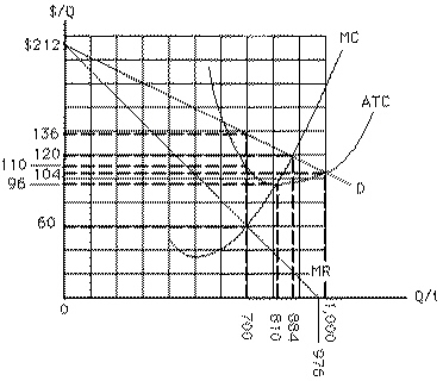 If the monopolist in Exhibit 9-11 chooses to produce 1, 000 units and does not price discriminate, its profit will be
If the monopolist in Exhibit 9-11 chooses to produce 1, 000 units and does not price discriminate, its profit will be
A) $0
B) $104, 000
C) $212, 000
D) maximized
E) negative
Correct Answer

verified
Correct Answer
verified
Multiple Choice
A monopolist has no supply curve because
A) as demand changes, each output level can be consistent with more than one profit-maximizing price
B) monopolists tend to restrict output
C) monopolists have no marginal cost curve
D) monopolists can charge any price they want
E) as demand changes, the firm's profit-maximizing choice of output may change
Correct Answer

verified
Correct Answer
verified
Multiple Choice
Exhibit 9-18 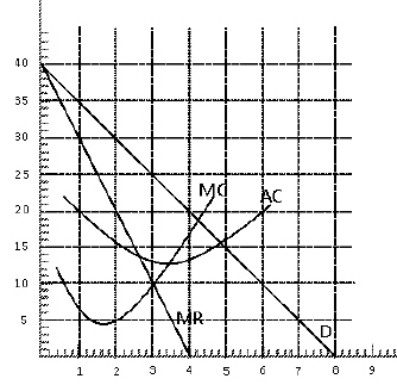 The firm in Exhibit 9-18, the monopolist who charges the same price to all customers, will produce how many units of output?
The firm in Exhibit 9-18, the monopolist who charges the same price to all customers, will produce how many units of output?
A) 1 unit
B) 2 units
C) 3 units
D) 4 units
E) 5 units
Correct Answer

verified
Correct Answer
verified
Multiple Choice
Exhibit 9-3 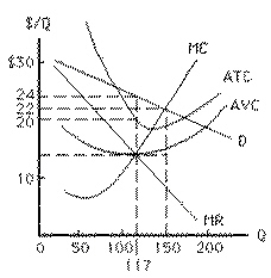 The total cost for the firm in Exhibit 9-3, a monopolist that maximizes profit while charging all customers the same price, is
The total cost for the firm in Exhibit 9-3, a monopolist that maximizes profit while charging all customers the same price, is
A) $3, 300
B) $3, 400
C) $2, 808
D) $2, 340
E) $1, 638
Correct Answer

verified
Correct Answer
verified
Multiple Choice
Exhibit 9-4  What is the revenue-maximizing output for the monopolist represented in Exhibit 9-4, assuming it does not price discriminate?
What is the revenue-maximizing output for the monopolist represented in Exhibit 9-4, assuming it does not price discriminate?
A) 0 units
B) 2 units
C) 3 units
D) 4 units
E) 5 units
Correct Answer

verified
Correct Answer
verified
True/False
With perfect price discrimination, each consumer is charged the marginal value of each unit consumed.
Correct Answer

verified
Correct Answer
verified
Multiple Choice
Exhibit 9-5 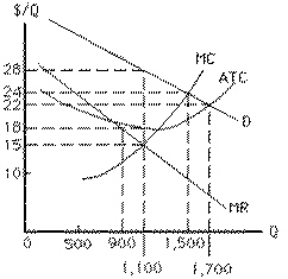 The total revenue for the nondiscriminating monopolist at its profit-maximizing quantity in Exhibit 9-5 is
The total revenue for the nondiscriminating monopolist at its profit-maximizing quantity in Exhibit 9-5 is
A) $16, 200
B) $36, 000
C) $39, 600
D) $30, 800
E) $31, 000
Correct Answer

verified
Correct Answer
verified
Multiple Choice
Exhibit 9-3 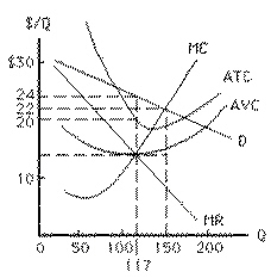 At the profit-maximizing output for the firm in Exhibit 9-3, the single price monopolist will charge _____ per unit of output.
At the profit-maximizing output for the firm in Exhibit 9-3, the single price monopolist will charge _____ per unit of output.
A) $30
B) $24
C) $22
D) $20
E) $10
Correct Answer

verified
Correct Answer
verified
Multiple Choice
Unlike firms in a perfectly competitive industry, monopolists have control over
A) the price they charge for the product
B) the quantity of output they produce
C) the prices they pay for resources
D) the quantities of various resources which are used
E) improvements in technology
Correct Answer

verified
Correct Answer
verified
True/False
A monopolist has complete control over both price and quantity of output.
Correct Answer

verified
Correct Answer
verified
True/False
Price discrimination will occur whenever a firm faces a downward-sloping demand curve.
Correct Answer

verified
Correct Answer
verified
Multiple Choice
The practice of charging different prices to different consumers of the same product is called
A) monopolistic pricing
B) unit pricing
C) price discrimination
D) elasticity pricing
E) marginal cost pricing
Correct Answer

verified
Correct Answer
verified
Multiple Choice
A profit-maximizing monopolist never produces along the __________ portion of the demand curve because marginal revenue is __________ there.
A) elastic; positive
B) elastic; negative
C) inelastic; negative
D) inelastic; positive
E) inelastic; zero
Correct Answer

verified
Correct Answer
verified
Multiple Choice
Jewelers are willing to hold large inventories of diamonds
A) because the demand for diamonds is large and growing
B) because that minimizes the fixed cost of producing diamond jewelry
C) because, given De Beers' control of the market, they are confident that the price of diamonds will not plummet rapidly
D) because, given De Beers' control of the market, they are confident that the price of diamonds will rise rapidly
E) because that is what their customers expect them to do
Correct Answer

verified
Correct Answer
verified
Multiple Choice
Exhibit 9-2  In Exhibit 9-2, the average revenue of the fourth unit is
In Exhibit 9-2, the average revenue of the fourth unit is
A) $12
B) $3
C) $4
D) -$4
E) $0
Correct Answer

verified
Correct Answer
verified
Showing 41 - 60 of 249
Related Exams